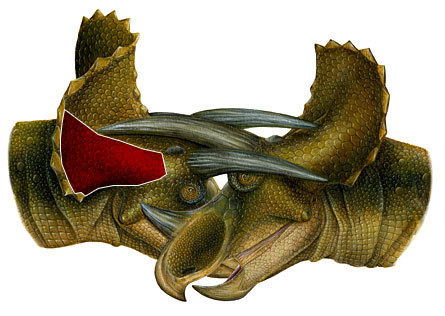Comparing the pattern and prevalence of lesions on the skulls of dinosaurs in the Triceratops genus with those of a short-horned cousin strongly suggests that Triceratops used their horns in head-to-head combat among themselves.

With a broad frill on the back of its skull and its trademark three horns — a small, rhino-style horn on the nose and a long one pointing forward from above each eyebrow — Triceratops are among the dinosaur era’s most recognizable creatures. Everyone from paleontologists to filmmakers and children, imaginative folks all, has envisioned the behemoth using its horns to defend itself against predators such as Tyrannosaurus rex. Now, research reported online January 27 in PLoS ONE hints that Triceratops used their brow horns to joust with each other.
Andy Farke, a vertebrate paleontologist at the Raymond M. Alf Museum of Paleontology in Claremont, Calif., and his colleagues reached this conclusion by analyzing the pattern and prevalence of lesions on various fossilized skull bones of adult Triceratops. Not all of the skulls were complete, so some bones showed up more often than others, he notes. The team counted lesions thought to represent the healing of fractures and superficial traumas, such as gouges and scrapes.
Of the 47 Triceratops skulls that included a nasal bone — the large bone that forms the bridge of the creature’s nose — none included lesions. Of the 58 squamosals — the bones that extend from behind the eye to the lower edge of the frill — that the team analyzed, 10 showed signs of healed injuries or fractures, says Farke. If Triceratops engaged in head-to-head combat with each other in battles for territory, food or mates, the brow horns of one grappler would have been long enough to reach, and possibly gouge or scrape, the squamosals of the other. Because the bones from the central portions of the frill didn’t have similar rates of damage, the team suggests that the lesions weren’t caused by predators or bacterial infections.
The skull of a close cousin of Triceratops, a creature called Centrosaurus, was built somewhat differently, with a relatively long nasal horn and relatively short brow horns. As in Triceratops, none of the Centrosaurus nasal bones had lesions. And of the 62 Centrosaurus squamosals that the team analyzed, only one preserved evidence of a healed wound or fracture.
The frequency of lesions on Triceratops squamosals and almost complete lack of them on similarly placed bones in Centrosaurus “is an intriguing pattern,” says Farke. “We can’t say that all of these lesions were caused by wounds,” but the overall pattern suggests that Triceratops tussled in head-to-head, frill-gouging combat and that Centrosaurus didn’t.
Attributing these skull lesions to combat “is very sexy” and is bound to attract a lot of attention “but it’s also very speculative,” says Mark Goodwin, a paleontologist at the University of California, Berkeley. “The evidence of different pathologies [in the two species] is not evidence of combat” in Triceratops, he adds, but the findings are “a first step” toward making a case. Detailed analyses of the bone in and around the lesions would help support the idea that Triceratops routinely engaged in combat, he suggests.
“Not all [such lesions] are the result of trauma,” cautions Bruce Rothschild, a paleopathologist at the University of Kansas’ Natural History Museum and Biodiversity Research Center in Lawrence. “It’s not clear what some of these lesions are,” he notes, but some could stem from bone development or be the result of stress fractures unrelated to combat.
No one has conducted detailed analyses of Triceratops horns, which are somewhat hollow at their bases, to determine whether they could stand up to the stresses that jousting might induce, says Farke. However, he notes, the oryx — a modern-day antelope with a similar horn structure — engages in fierce combat with its horns. “It’s safe to say that [their horns] could stand up” to such stresses, he contends.
The team’s statistical analyses are “suggestive but not conclusive,” says Elizabeth Rega, a paleopathologist at Western University of Health Sciences in Pomona, Calif. Nevertheless, “this is an important paper and a terrific start … that raises more questions,” she adds. “This is the beginning of their research, not the end.”






